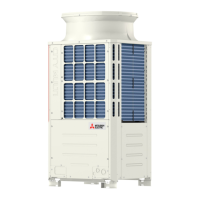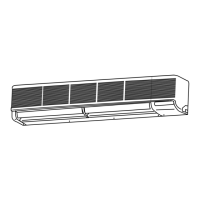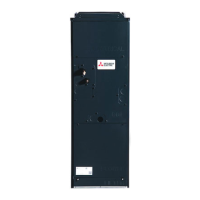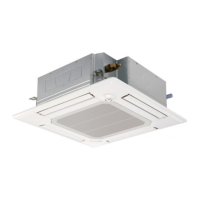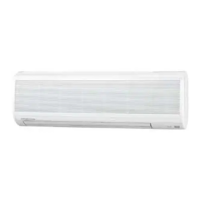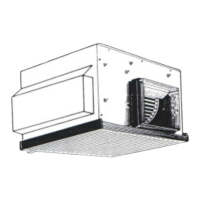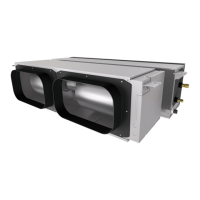–108–
Checking code Meaning, detecting method Cause Checking method & Countermeasure
1301
1302
Low pressure
abnoramlity
High pressure
abnoramlity 1
(Outdoor unit)
When starting from the stop mode
for the first time, (if at the start of bind
power transmission, the end of bind
power transmission, and in the mode
when the thermostat goes OFF im-
mediately after the remote control
goes ON, the following compressor
start time is included), if the low pres-
sure pressure sensor before start-
ing is at 0.098MPa, operation stops
immediately.
1. When pressure sensor detects
2.47MPa or higher for the first
time, the outdoor unit stops,
goes into restart mode after 3
minutes, then restarts.
2. When
2.94MPa
or higher pres-
sure is detected again (the sec-
ond time) within 30 minutes af-
ter stop of outdoor unit,error
stop is observed with code No.
“1302” displayed.
3. When
2.47MPa
or higher pres-
sure is detected 30 or more
minutes after stop of outdoor
unit, the detection is regarded
as the first time and the process
shown in 1 is observed.
4. Thirty minutes have past since
the outdoor unit first stopped
and no stop for this reason has
occurred for 30 minutes, the
preliminary fault code “1202”
will be displayed.
5.
Error stop is observed immediately
when press. switch
(2.94 MPa)
operates in addition to pressure
sensor.
1) Internal pressure is dropping due
to a gas leak.
2) The low pressure pressure sensor
is defective.
3) Insulation is torn.
4) A pin is missing in the connector,
or there is faulty contact.
5) A wire is disconnected.
6) The control board’s low pressure
pressure sensor input circuit is de-
fective.
1) Poor operations of indoor LEV.
2) Poor operations of BC controller
LEV:
Heating-only, heating-principal:
LEV3
Defrost: LEV3
3) Poor operations of BC controller
SVM1:
Cooling-only, defrost
4) Poor operations of BC controller
SVA:
Cooling-only, cooling-main
5) Poor operations of BC controller
SVB:
Heating-only, heating-main
6) Solenoid valve SV (3 ~ 8) trouble
Cooling-only, cooling-main
Refer to the item on judging low pres-
sure pressure sensor failure.
Check operations status by actually
performing cooling or heating opera-
tions.
Cooling : Indoor LEV
LEV1, 3 (BC)
SVM SVA (BC)
SV3~8
Heating : Indoor LEV
LEV3 (BC)
SVB (BC)
See Trouble check of LEV and sole-
noid valve.
+0
-1.5
7) Setting error of connection address.
8) Poor operations of ball valve.
9) Short cycle of indoor unit.
10)Clogging of indoor unit filter.
11)Fall in air volume caused by dust
on indoor unit fan.
12)Dust on indoor unit heat exchanger.
13)Indoor unit fan block, motor trouble.
8)~13) : Rise in high pressure
caused by lowered condensing
capacity in heating-only and
heating-principal operation.
14)Short cycle of outdoor unit.
15)
Dust on outdoor unit heat exchanger.
16)
Outdoor unit fan block, motor trouble,
poor operations of fan controller.
14)~16):Rise in high press.
caused by lowered condensing
capacity in cooling-only and
cooling-pincipal operation.
17)
Poor operations of solenoid valves
SV1, 4a (Bypass valves (SV1, 4a)
can not control rise in high pressure).
18)Thermistor trouble (TH2, TH5, TH6).
19)Pressure sensor trouble.
20)Control circuit board thermistor
trouble, press. sensor input circuit
trouble.
Check address setting of indoor unit
connector.
Confirm that ball valve is fully open-ed.
Check indoor unit and take measures
to trouble.
Check outdoor unit and take measures
to trouble.
Check outdoor unit fan
See Trouble check of outdoor unit
fan.
See Trouble check of solenoid valve.
Check resistance of thermistor.
Check Trouble check of pressure
sensor.
Check inlet temperature and press. of
sensor with LED monitor.

